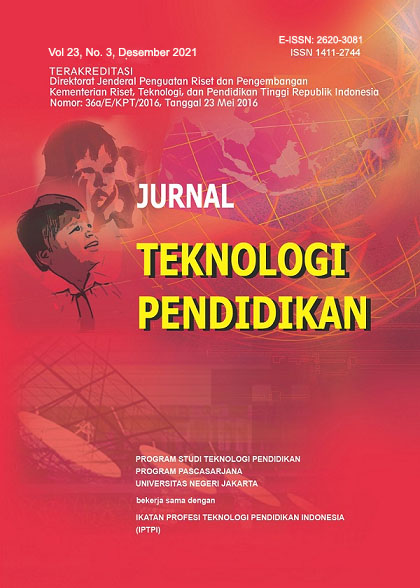Develovment Of Video Tutorials To Making Embroidery Terawang For Embroidery Courses
DOI:
https://doi.org/10.21009/jtp.v24i3.47342Keywords:
Development, Learning Video, Embroidery TerawangAbstract
This research aims to develop a video tutorial for Embroidery Terawang, so that students are able to understand and carry out learning activities independently during activities from home. This type of research is research and development, while the research method used is the 4D development model which consists of define, design, development and disseminate, but in this research it only reaches the development stage. The data in this study are primary data obtained from a questionnaire on the validity and practicality of the product. The validity of the product was carried out by 2 media validators and 2 material validators. The subjects in this study were 1 lecturer for the embroidery course, 15 students for the small group trial and 50 students for the large group trial consisting of D-III and S1 students in the Department of Family Welfare Science in the year of entry. 2020. The product produced from this study is the Embroidery Terawang video tutorial in the Sulaman course with a validity test value obtained by a percentage of 84.13% with a very valid category. Meanwhile, the practicality test for the subject supervisory lecturers obtained a percentage of 91.6% with the very practical category, the small group practicality test was 87% with the very practical category and the large group practicality test obtained a percentage of 87.7% with the very practical category. Based on the research results, it can be concluded that the Embroidery Terawang video tutorial in the Embroidery course for fashion students of the FPP-UNP Family Welfare Science Department developed is very valid and very practical.
References
Arikunto, S. (2006). Prosedur Penelitian Suatu Pendekatan Praktek. Jakarta: PT. Rineka Cipta.
Arikunto, S. (2010). Prosedur Penelitian. Jakarta: PT. Rineka Cipta.
Arsyad, A. (2013). Media Pembelajaran. Jakarta: Raja Grafindo Persada.
Astuti, M. (2019). Pengembangan Media Pembelajaran Menggunakan Video Mata Kuliah Dasar Tata Rias Program Studi Pendidikan Tata Rias Dan Kecantikan FT UNP. Pakar Pendidikan, 12(2), 118–127.
Cheppy, R. (2007). Pedoman Pengembangan Media Video. Bandung: Program P3AI Universitas Pendidikan Indonesia.
Daryanto. (2010). Media Pembelajaran: Peranannya Sangat Penting dalam Mencapai Tujuan Pembelajaran (1st ed.). Yogyakarta: Gava Media.
Daryanto. (2013). Inovasi Pembelajran Efektif. Bandung: Yurma Widya.
Kustandi, C., & Sutjipto, B. (2011). Media Pembelajaran; Manual dan Digital. Bogor: Ghalia Indonesia.
Riduwan. (2012). Skala Pengukuran Variabel-variabel Penelitian. Bandung: Alfabeta.
Rusman. (2011). Pembelajaran Berbasis Teknologi Informasi Dan Komunikasi. Jakarta: Rajawali Press.
Sadima, A. S. (2011). Media Pendidikan Pengertian, Pengembangan dan Pemanfaatannya. Jakarta: Rajawali Press.
Sadiman, A. S. (2015). Media Pendidikan Pengertian, Pengembangan, dan Pemanfaatannya. Jakarta: PT. Raja Grafindo Persada.
Samala, A. D., Ambiyar, A., Jalinus, N., Dewi, I. P., & Indarta, Y. (2022). Studi Teoretis Model Pembelajaran: 21st Century Learning dan TVET. Edukatif: Jurnal Ilmu Pendidikan, 4(2), 2794–2808.
Sugiyono. (2017). Penelitian dan Pengembangan: Research and Developmeny (R&D). Bandung: Alfabeta.
Sujadi. (2003). Metodologi Penelitian Pendidikan. Jakarta: Rineka Cipta.
Wasia, R. O. (2009). Keterampilan Menghias Kain. Bandung: Angkasa.
Yuliarma. (2013). Desain Ragam Hias Sulaman dan Bodir, Desain Motif Dasar. Universitas Negeri Padang.
Yuliarma. (2016). The Art of Embroidery Designs. Jakarta: Kepustakaan Populer Gramedia.
Yusmerita. (1992). Teknik Menghias Busana dan Lenan Rumah Tangga. IKIP FPTK Padang.
Zullkarnaen, Y. (2006). Sulam Benang untuk Pemula. Jakarta: Puspa Swara.
Downloads
Published
How to Cite
Issue
Section
License
Jurnal Teknologi Pendidikan is an Open Access Journal. The authors who publish the manuscript in Jurnal Teknologi Pendidikan agree to the following terms.
Attribution-ShareAlike 4.0 International (CC BY-SA 4.0)
-
Attribution — You must give appropriate credit, provide a link to the license, and indicate if changes were made. You may do so in any reasonable manner, but not in any way that suggests the licensor endorses you or your use.
-
ShareAlike — If you remix, transform, or build upon the material, you must distribute your contributions under the same license as the original.
- No additional restrictions — You may not apply legal terms or technological measures that legally restrict others from doing anything the license permits.
Notices:
- You do not have to comply with the license for elements of the material in the public domain or where your use is permitted by an applicable exception or limitation.
- No warranties are given. The license may not give you all of the permissions necessary for your intended use. For example, other rights such as publicity, privacy, or moral rights may limit how you use the material.








